 John Oliver examines what's behind stylish cheap clothes. John Oliver examines what's behind stylish cheap clothes.
Tags: capitalism, consumption/consumerism, corporations, economic sociology, globalization, apparel, fashion, supply chains, sweatshops, 11 to 20 mins
Year: 2015 Length: 17:09 Access: YouTube Summary: In this clip from Last Week Tonight, John Oliver analyzes the rise of fast fashion and its tremendous profits. Fast fashion includes short times from design to rack, with fashion styles changing constantly at companies such as H&M, Zara, and Forever 21. But news commentators are shown marveling at the very low costs of the trendy, fashionable clothes. Given these low costs, Oliver asks “How does any clothing company make money?” After all, the industry has many billionaire founders and executives, whose companies excel with high-volume sales. The reality is that 2% of clothing worn by Americans is made in the US, while the rest is produced overseas and often in sweatshop conditions. Oliver frames this in terms of the outrage over sweatshop clothing producers in the 1990s, by companies such as Nike, Gap, and most famously, Kathie Lee Gifford. In response to protests, many of these large companies agreed to monitoring programs in their supply chains. So how have their production conditions changed? In more recent years, undercover journalists investigating Gap and Wal-Mart found child slaves; non-compliance with workplace safety standards; and repeated denial of responsibility for any wrong-doing. One particular issue is that contractors producing clothes for Wal-Mart must follow certain standards, but contractors frequently send this work to sub-contractors; when the sub-contractors violate labor standards, Wal-Mart denies any knowledge that their clothes were being produced in these factories. However, this issue is far from an isolated event, and Wal-Mart repeatedly denies awareness of these issues. This dynamic is not unique to any manufacturer, but it reflects supply chain issues that are fundamental to the global economy, and are an important part of understanding global inequality and our own participation (as consumers) within it. Submitted By: Paul Dean
25 Comments
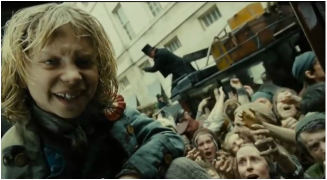 A boy sings to the rich about the plight of the poor. A boy sings to the rich about the plight of the poor.
Tags: capitalism, class, economic sociology, inequality, marx/marxism, political economy, theory, class consciousness, class conflict, 00 to 05 mins
Year: 2012 Length: 2:48 Access: YouTube Summary: This clip from the 2012 film of the musical Les Misérables begins by showing beggars and urchins pressing against the carriages of the rich, begging for food or money. Gavroche, the lead urchin, explains to the audience the political situation in France (in 1832) and then joins a crowd of people expressing their anger at the situation so many of them are in. For the most part, the classes are polarized binto the rich and the poor (lower and upper classes). Particularly in the case of the working class, there seems to be minimal gap between their actual needs and experiences and their attitudes toward their situation. The scene and its accompanying song reflect key concepts in much of Marx and Engels' Manifesto of the Communist Party. For example, it illustrates the lower class's class consciousness, as both their objective class position and subjective consciousnesses are aligned; they realize their own position in the class system and how it affects them. As noted by Marx and Engels, the poor can “live only so long as they find work, and who [can] find work only so long as their labour increases capital” and are therefore wholly dependent on the upper class for their livelihood. However, the upper class is not acting in the interests of these poor, and the leaders that could make decisions to the benefit of the poor are absent and unhelpful. Therefore, the only people that can act in the interests of the lower class are the poor themselves. In order to live the life they want to live, the poor need to rise up collectively and make the necessary changes in the system. As this collective action is “continually being upset again by…the workers themselves” (Marx), the young men function to facilitate the inevitable conflict with the upper class. When Gavroche explains the continuous political loop the people have been in, finding themselves struggling again after seeming to have fixed the problem, he demonstrates the idea that class struggle is continuous and, according to Marx, present in “the history of all hitherto existing society.” With this understanding of the sociological factors in play in this clip, the viewers can make connections between the clip, albeit fictional, and other instances of class conflict throughout history. It is a strong representation of the differences between different classes and the consciousness that leads to conflict and change. Submitted By: Kiersten Payne 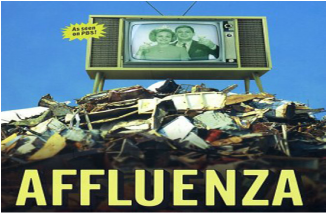 Affluenza is a combination of "affluence" and "influenza" to critique the disease of consumerism. Affluenza is a combination of "affluence" and "influenza" to critique the disease of consumerism. Tags: capitalism, class, consumption/consumerism, culture, economic sociology, health/medicine, inequality, marketing/brands, affluenza, american dream, keeping up with the joneses, status treadmill, 06 to 10 mins, 21 to 60 mins Year: 1997 Length: 10:13 (entire documentary is 56:00) Access: YouTube Summary: This clip (start 2:12; end 12:35) from the documentary Affluenza (based on the book), defines the concept and consequences of affluenza. Using the metaphor of disease, affluenza can be defined as a bloated, sluggish and unfulfilled feeling that results from efforts to keep up with the Joneses; an epidemic of stress, overwork, waste and indebtedness caused by dogged pursuit of the American Dream; and an unsustainable addiction to economic growth. This clip notes that "never before has so much meant so little to so many." It can cause headaches and depression amongst other symptoms, and the narrator notes that if it goes untreated, the disease can cause "permanent discontent." In addition to discussions of consumer culture, the clip works particularly well with the book, The Spirit Level. Using a variety of quantitative data, authors Wilkinson and Pickett argue that more unequal societies suffer a variety of social problems. The reason, they propose, is that more unequal societies place more emphasis on material success to prove one's worth in society. This constant drive to display one's material success can never be satisfied and leaves individuals throughout the social hierarchy being unfulfilled. In other words, unequal societies are more likely to suffer from affluenza, and the negative social and health outcomes (e.g. lower life expectancy, higher infant mortality, higher mental illness, higher drug use, etc). The narrators in the video clip further note that while the disease is very contagious (due to extensive marketing and the rise of consumer culture), it is treatable. Viewers might peruse the videos in our social movements category and other web resources for ideas of how to cure affluenza. The documentary website from PBS also offers a teaching guide. Submitted By: Paul Dean 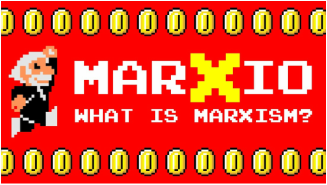 A vintage video game is used to discuss Marxism. A vintage video game is used to discuss Marxism. Tags: capitalism, class, economic sociology, marx/marxism, political economy, theory, alienation, dialectical materialism, philosophy, subtitles/CC, 00 to 05 mins Year: 2014 Length: 3:51 Access: YouTube Summary: This video is part of a series of 8-bit Philosophy, which seeks to “communicate even the most complex of philosophical concepts in a fun, easy-to-understand way.” It uses vintage video games (from the original Nintendo) to explain complex philosophical ideas. Using quotes from The German Ideology and other works, with altered scenes from Super Mario Brothers, the narrator explains several concepts within Marxist theory. For example, the narrator explains that Marx argued it was not ideas that drive historical change, but "it is our conflict arising out of our relation to material goods" that shapes history. This process of historical materialism is explained in terms of the economic systems and social relations of a society; it is simultaneously illustrated using a character from the video game (Toad) and its weapons (a turnip) that reflect commodities that the character produces. Other concepts include exploitation, the four forms of alienation, and communism—all placed in the context of familiar Super Mario Bros references, such as Bowser, collecting coins, and the classic background music. Submitted By: Paul Dean 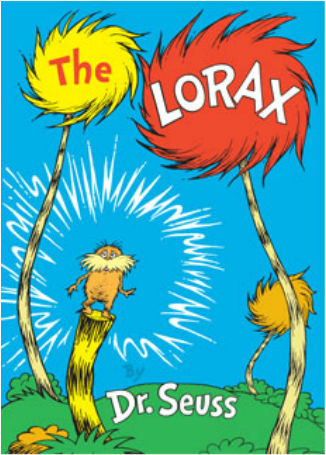 The Lorax warns that industrial activity will destroy our natural environment. The Lorax warns that industrial activity will destroy our natural environment. Tags: capitalism, consumption/consumerism, economic sociology, environment, theory, ethical consumption, externalities, industrial production, ipat formula, markets, 21 to 60 mins Year: 1972 Length: 25:13 Access: YouTube Summary: Written by Dr. Seuss, The Lorax is a children's book that tells the story of a stereotypical industrialist who clear-cuts a forest of trees to produce "Thneeds" for growing consumer markets. The Lorax, who "speaks for the trees," continuously but unsuccessfully explains that the industrial activity is destroying the forest and the homes of its many animals. The industrialist, Mr. Onceler, explains he is only "meeting consumer demand" and that "if I didn't, someone else would." But eventually, the trees are gone and the landscape is destroyed, thus making Mr. Onceler's business go bankrupt. Seeing the errors he made, Mr. Onceler encourages a boy passing by to plant new Truffula trees and regrow the forest. The original cartoon based on the book offers a familiar and entertaining way to discuss the relationship between industrial production, consumption, and environmental problems (note the cartoon was more recently made into a computer-animated film with 70+ controversial product-placements, offering additional points of discussion). The cartoon illustrates many key concepts, including the externalization of environmental costs, the consumer demand that partially drives the treadmill of production, and the popular IPAT forumla (Impact = Population X Affluence X Technology) for conceptualizing factors that explain environmental degradation. However, as Maniates (2001) argues in "Individualization: Plant a Tree, Buy a Bike, Save the World?," the story narrowly suggests individualistic solutions. He argues the proposed "response half-consciously understands environmental degradation as the product of individual shortcomings (the Once-ler's greed, for example), best countered by action that is staunchly individual and typically consumer-based (buy a tree and plant it)" (pp. 32-33). As such, the video can be used to distinguish the individualist explanations of production and consumption, from the more sociological explanations that link Mr. Onceler and the Lorax's activities to broader structural and institutional forces (and the limits of consumer-driven prospects for change). Maniates further notes that the popular IPAT formula excludes several important factors related to power and governance that impact environmental degradation. Another interesting theme, noted by Maniates (p. 32), is the "seeming inability of science (represented by the fact-spouting Lorax himself) and objective fact to slow the damage." Submitted By: Paul Dean 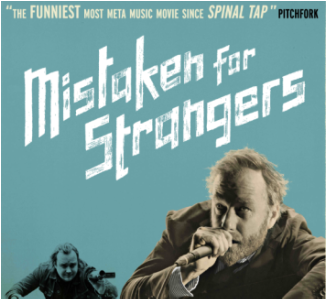 Why do siblings have such different economic & social outcomes? Why do siblings have such different economic & social outcomes? Tags: children/youth, class, economic sociology, inequality, marriage/family, family inequality, parenting, pecking order, siblings, 61+ mins Year: 2013 Length: 75:00 Access: no free online access (trailer here) Summary: In The Pecking Order, sociologist Dalton Conley explains how inequality occurs among adult siblings within families. Drawing on studies that look at hundreds of families, Conley shows that, rather than genetics or simple birth order, a variety of factors constitute a "pecking order" within families. The findings are well illustrated in Mistaken for Strangers, a 2010 documentary on the rock band The National. As noted by the filmmakers, "Matt, the lead singer of the critically acclaimed rock band The National, finally finds himself flush with success. His younger brother, Tom, is a loveable slacker--a filmmaker and metal-head still living with his parents in Cincinnati. On the eve of The National's biggest tour to date, Matt invites Tom to work for the band as a roadie, unaware of Tom's plan to film the entire adventure. What starts as a rock documentary soon becomes a surprisingly honest portrait of a charged relationship between two brothers, and the frustration of unfulfilled creative ambitions." In the film, Tom does not have an organized agenda for the movie’s plot, which leads him to struggle with both himself and his brother Matt. Because of his drinking, Tom hardly fulfills his crew duties, which creates conflict and tension between the brothers. The crew finally fires him in the middle of the tour. Tom returns to his parents’ home heartbroken and frustrated. He wonders why he and Matt are so different, so he interviews his parents about their opinions. His father focuses on the fact that Tom “failed” as he does not have a “prestigious” career and live with his parents, in comparison to Matt who has been very “successful.” His mother on the other hand describes Tom as someone who was a difficult child, who cried and never completed tasks. However, she mentions that she was always hopeful of him to be successful because he is “the most talented, skilled one.” This highly rated documentary proves her intuition. Although they grew up in the same context with the same resources and parents, what made Matt and Tom ranked differently in the social ladder? The family interviews of Tom reveals that there is a clear “pecking order” between the siblings in Berninger family. This documentary turns out be an excellent case for understanding inequalities between siblings and within families. I asked my students to first read three chapters of The Pecking Order and reflect on their own experiences with their parents and siblings. Then, I show the documentary and asked them to explain the sources of the inequalities between the siblings. Submitted By: Nihal Çelik 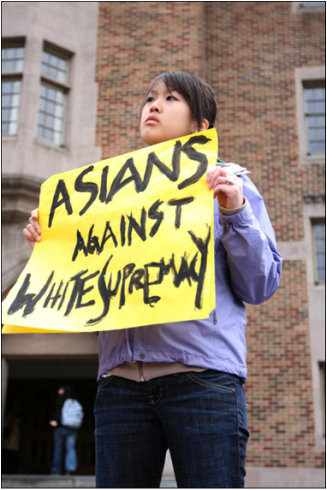 A student protests at the University of Washington (photo by Nick Feldman) A student protests at the University of Washington (photo by Nick Feldman)
Tags: economic sociology, education, inequality, methodology/statistics, organizations/occupations/work, prejudice/discrimination, race/ethnicity, aapi, asian american, income inequality, institutional discrimination, racism, white privilege, white supremacy, 00 to 05 mins
Year: 2014 Length: 2:43 Access: YouTube Summary: Here's an empirical fact that isn't acknowledged nearly enough: the United States is a white supremacist state. It has been a white supremacist state from the late 18th century right up to the present day, and while this conclusion may strike many as provacative or vulgar, it is not controversial among those who rely on empirical data to inform their views. To put it in different terms, there is a racial hierarchy in the U.S. and whites are at the top. White folks—myself included—receive the lion's share of power, privilege, and resources. Needless to say, whites are not inherently better or more deserving; nor have we received a disproportionate share of assets and resources because we have worked harder than People of Color. Our privileged position is because the institutions Americans navigate each day have been built to favor whites. Borrowing from writer John Scalzi's video game metaphor, whiteness affords those who have it the ability to play the game of life on the lowest difficulty setting. Metaphors are useful, but where is the evidence? In short, the evidence is everywhere. One need only look at patterns of housing discrimination, employment discrimination (and here), racial profiling (and here), incarceration, various health outcomes, poverty, wealth inequality, and income inequality, to name a few. But look once more at that last link on income inequality. Did you notice that in 2011 among full-time wage and salary workers in the United States, Asian Americans took home $872 on average compared to whites, who took home nearly $100 less? In a recent essay regarding Asian American discrimination, sociologist Tanya Maria Golash-Boza reported that by 2013 the pattern hadn't changed. Asians’ median weekly earnings were $973, as compared to $799 for whites. If Asians earn more, then why don't sociologists argue the U.S. is actually an Asian supremacist state? Or as the right-wing commentator Bill O'Reilly suggests in the above video, isn't it more accurate to talk about Asian privilege rather than white privilege? The video is useful for spurring discussion on this important topic, and I will conclude this post by suggesting a sociologically-informed "talking points" reply to O'Reilly. First, the average earnings statistic conceals the enormous variation found among different Asian subgroups. Given the disparity in earnings between Asians whose families immigrated from Southeast Asia and those from China, it is arguably misleading to lump these subgroups together. Second, education is a confounding variable, which is a shorthand way of saying that the income graph is misleading in yet another way. Asians look like they earn more than whites, but this is only because Asians have more education on average. The reason why Asians have higher average levels of education is a topic The Sociological Cinema has tackled elsewhere, but what O'Reilly's narrative of Asian privilege cannot explain away is the fact that when one compares whites and Asians who are in the same field, live in the same place, and have the same level of education, whites earn more (see Kim et al., 2010). Third, just as the election of Barack Obama did not suddenly end racism in the U.S., the determination of whether the United States is white supremacist does not hinge on a single measurement of well-being. Even if one makes the incredible leap of faith and believes Bill O'Reilly is competantly grasping the available data, it is important to remember that the labor market is but one dimension of human experience and only one place where racism has been measured. For instance, O'Reilly has not even begun to address cultural dimensions of white supremacy, such as white standards of beauty and masculinity. Submitted By: Lester Andrist  The Healing Blues Project communicates the struggles of homelessness. The Healing Blues Project communicates the struggles of homelessness. Tags: art/music, community, economic sociology, inequality, media, affordable housing, empowerment, homelessness, 00 to 05 mins Year: 2014 Length: 5:05 Access: YouTube Summary: This music video, "I Die a Little," offers a first person narrative written and created by a sociology professor, media theorist, journalist, and a woman experiencing homelessness. Amidst the lyrics describing the struggles of homelessness, facts and statistics about homelessness appear throughout the video. It notes, for example, that "teens age 12 to 17 are more likely to become homeless than adults" and that "1 in 6 Americans live on incomes that put them at risk for hunger." Accordingly, it conveys both the structural causes of homelessness (e.g. lack of affordable housing and low-wage jobs) and its human face. The video is part of The Healing Blues Project, a community based project spearheaded by Greensboro College that partners local musicians, artists, and philanthropists with individuals from the homeless community in order to share their experience, strength, and hope. The larger collection (Healing Blues Vol 1) tells the stories of 13 individuals, all different yet somehow the same; they are joined together through the messages of humanity, hope, and love expressed in their songs. Proceeds from the Healing Blues Project go to the Interactive Resource Center, a community based outreach and resource provider, in Greensboro, North Carolina. The musicians from Haymarket Riot donated their performances to the project, and the homeless storytellers, as co-authors of the songs, receive a share of the royalties. It is also an example of the authors' use of cybertheory, which they describe as using the current technologies of postmodernity "to produce a multimedia theoretical 'text.'” Submitted By: HayMarket Riot  Dropping a letter from his name was important to job market success. Dropping a letter from his name was important to job market success. Tags: economic sociology, inequality, organizations/occupations/work, prejudice/discrimination, race/ethnicity, hiring, hispanic, institutional discrimination, labor market, racism, stratification, 00 to 05 mins Year: 2014 Length: 1:10 Access: HuffPost Summary: In this brief video, José Zamora describes his frustrations applying to jobs and never getting responses from employers. He states that after sending out 50-100 applications per day, for months, he never received any responses from employers. He tried dropping the "s" from his name, becoming Joe Zamora. Within 7 days, he started getting responses from the same employers, using the same resume. José explains "I don't think people know, or are conscious or aware that they're judging, even if it's by a name. But I think we all do it all the time." Viewers might be encourage to wonder how our race and ethnicity is signaled and interpreted? How might this shape labor market outcomes and social stratification? While this description is only anecdotal evidence of racial discrimination, it is widely supported by audit studies that have tested for racial discrimination on the labor market. For example, we have previously written about institutional discrimination in this Freakonomics clip, where economist Sendhil Mullainathan discusses his (and co-author Marianne Bertrand's) 2004 field experiment that examined racial discrimination in the labor market (article here). They sent out 5,000 resumes to real job ads. Everything in the job ads was the same except that half of the names had traditionally African-American names (e.g. “Lakisha Washington” or “Jamal Jones”) and half had typical white names (e.g. “Emily Walsh” or “Greg Baker”). As they illustrate, people with African-American-sounding names have to send out 50% more resumes to get the same number of callbacks as people with white-sounding names. This study is further supported by Devah Pager's (2003) classic audit study, where she documented similar effects of racial discrimination through in-person applications. Thanks to Meredith Harrison for suggesting this clip! Submitted By: Paul Dean 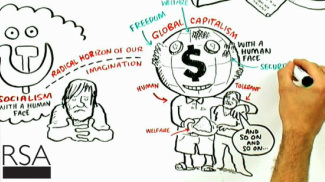 Žižek argues charitable consumption prolongs capitalism's ills. Žižek argues charitable consumption prolongs capitalism's ills. Tags: capitalism, consumption/consumerism, corporations, culture, economic sociology, marketing/brands, marx/marxism, political economy, theory, charity, corporate social responsibility, cultural capitalism, morality, starbucks, žižek, 06 to 10 mins Year: 2010 Length: 10:56 Access: YouTube Summary: In this animated segment of a longer lecture, Slavoj Žižek critiques the cultural dimensions of contemporary capitalism. Žižek begins by stating how capitalism has changed from a dichotomy between production and traditional charity (e.g. Soros earns money by exploiting workers then gives it back to humanist causes), to a form of capitalism that brings the dimensions of morality and consumption together. He offers several examples of this "cultural capitalism," including Starbucks and Tom's Shoes. In each of these instances, the act of consumption and doing good are part of the same process, which has now been universalized throughout capitalism. It is meant to make people (i.e. consumers) feel good about themselves in that they are helping poor people or a degraded environment. However, Žižek argues that by participating in this system, consumers are actually "prolonging the disease ... rather than curing it." He promotes changing the structure rather than this sort of charitable act: "The proper aim is to try and reconstruct society on such a basis that poverty would be impossible and the altruistic virtues have really prevented the carrying out of this aim." He compares this system to slave owners who were kind to their slaves because they prevented oppressed slaves from realizing the core injustice of slavery; in other words, it suggests that we are doing enough to address the system's ills and prevents more significant change. While there is an implicit argument to do away with capitalism here, Žižek explicitly states that 20th century socialism was a "mega catastrophe" and does not promote a return to that system. The clip also works well to initiate critical discussions of corporate social responsibility, Fair Trade, and other social certifications, and begin to imagine what more radical alternatives might look like. Submitted By: Paul Dean |
Tags
All
.
Got any videos?
Are you finding useful videos for your classes? Do you have good videos you use in your own classes? Please consider submitting your videos here and helping us build our database!
|
 RSS Feed
RSS Feed
